Basketball drills for technique defense
- Centers + Guards + Forwards - from U12
- 2 or more players
- 1 ball per pair
- two baskets
Prerequisites
- being able to run a layup at speed from the pass
Objective:
- speed dribble is along the sideline because the shortest route to the other side
- pass and catch on speed
Organization:
- player takes a free throw and captures the rebound
- catch the ball as high as possible
- 3 sprints to the outlet position and calls
- passes with an overhead pass to the outlet
- the man with the ball dribbles along the sideline to the other basket as quickly as possible
- defender over the axis of the field to the other side
- receives the pass at full speed
- and makes the lay up without dribbling
Teaching Points:
- sprinting
- communication
- correct dribble start
- push the ball at the speed dribble
- dribbler must see where the flyer is
- pass in time
- shooter catches his own ball
- passer sprints under the circle to the outlet on the other side
- calls
- receives the ball at the outlet position with an overhead pass
- both players run the same 2 on 0 break as on the way out
- but now on the other longitudinal half of the field
Variation:
- put 1 defender at each basket
- defender catches ball and gives outlet pass
- and becomes flyer
- shooter becomes defender
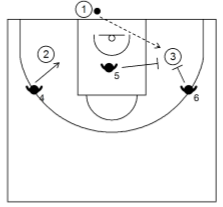
Prerequisites:
- Players can defend on their feet
- and be able to pass
Objective:
- to practice the double team in the arrow press
- and the first rotation
Organization:
- 1 takes the ball and then does not take part in the game, but counts down the 8 seconds
- the defenders allow the first pass
- (in case of 5 players, one of the attackers starts with a pass to himself or to the other and the weak side defender counts down) Â- defender 5 starts to double team immediately after the first pass Â- the weak side defender passes the pass to the free attacker
- If the attackers get on the offensive half within 8 seconds they have a point Â- if the defenders win the ball they attack the basket. A score is a point. Â- The attacker calls when there is a foul on him. Point for the attack.
- play 5 times in a row with the same teams
- loser must run
Teaching points:
in double team, the attacker is NEVER allowed to pass between the defenders Â- the third defender must use all his energy to make the pass impossible Â- if a defender in double team is beaten by the ball, he must sprint full speed to regain a position between the ball and the half way line
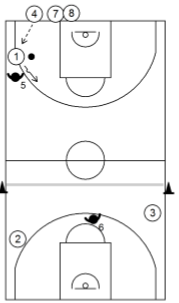
Prerequisites:
players on the dribble can defend Â- and can make a pass the length of the field
Objective:
to practice defending the backfield in the arrowpress Â- to anticipate the pass and always make sure you are in a position to intercept it
Organisation:
- 4 takes the ball and then does not take part in the game anymore, but counts down the seconds
- defender 5 applies maximum pressure on the dribbler
- the defenders can defend all over the field
- attacker 1 may only act on the defensive half Â- attackers 2 and 3 only on the offensive half
- after a stop or score, defender 5 takes the ball back for the next round
- if the attackers score within 10 seconds they have a point Â- if not, it is a point for the defenders Â- the attacker calls if there is a foul on him. Point for the attack.
- play 5 times in a row with the same defenders
- 3 new attackers each time.
- If the defenders make less than 2 stops, they must run.
- when there are 2 or more stops, all attackers must run.
Teaching points:
defend the dribbler on your feet - he may not pass you under any circumstances Â- arms wide to make a pass difficult Â- defender 6 must anticipate the long pass to intercept it Â- must position himself so that he can see the ball AND both other attackers as much as possible (split vision) Â- always adjust his position on the field to intercept the most likely pass Â- if he has not been able to intercept the long pass, Â- He must NOT allow a lay up Â- Defender 5 must then sprint full speed towards the free attacker on the weak side.
Variations:
In the beginning, you may have to limit the space for attackers 2 and 3. Use existing lines on the floor, or place pawns on the sidelines on the attacking half.
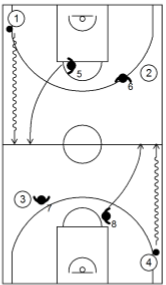
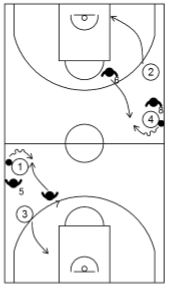
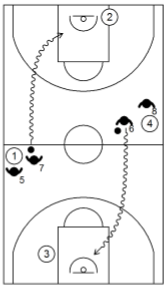
Requirements:
players must be able to individually defend the man with the ball Â- players must be able to dribble
Objective:
Force the dribbler to make a reverse dribble at the sideline and second defender goes for the steal.
Organization:
- 2 against 2 across the length
- losers must defend in the next round
- the trapper anticipates the reverse of the dribbler and taps the ball away as soon as the dribbler has turned 180 degrees Â- completes the lay up on the other basket
- a steal is 3 points Â- a 'normal score' by the attackers is 1 Â- the pair that has 12 points first wins Â- losers walk suicide
Teaching Points:
defender forces dribbler to the side, but must keep an appropriate distance, taking into account the dexterity and speed of the dribbler Â- defender must force the dribbler to the side so that he will make a reverse dribble
Variations:
- left and right
- with triplets half court; third defender must release his own man as soon as the attempted steal begins and cut off passing lines
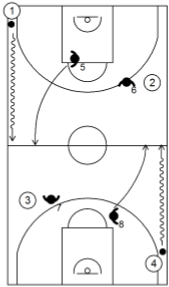
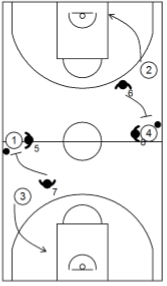
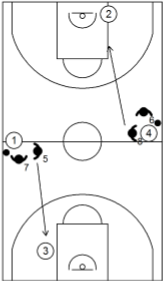
Requirements:
players must be able to individually defend the man with the ball Â- players must be able to dribble
Objective:
Set up kick directly over the center line.
Organization:
2 against 2 across the longitudinal half Â- losers must defend in the next round Â- the dribbler must be over the centre line within 4 seconds (the trapper counts down)
the trapper moves aggressively towards the half way line just before the dribbler crosses it (but due to his speed and the position of his defender is not able to change direction) Â- the trapper widens himself, but moves the foot closest to the touchline backwards slightly, so that he can close the touchline with 1 or 2 slides Â- the dribbler must never pass between the two defenders
As soon as the dribbler grabs the ball, the trapper stays with it Â- the other defender sprints towards the free attacker
Teaching Points:
defender forces the dribbler to the side, but must keep an appropriate distance, taking into account the dexterity and speed of the dribbler Â- defender must force the dribbler to move at high speed along the touchline to the attacking half
Variations:
left and right
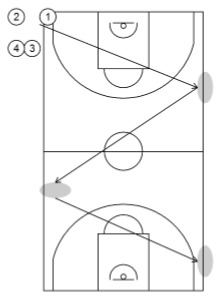
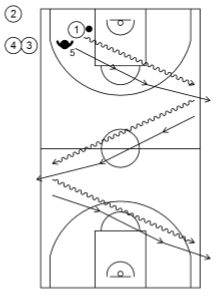
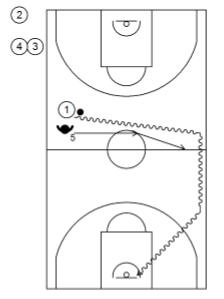
Requirements:
Players must be able to sprint and slide and switch between them Â- Players must be able to dribble
Goal: Press
the dribbler on the press
Organisation:
Have each player sprint fully along the drawn lines and always close off the touchline (set up cones) idem but now with slides idem with alternating slides - sprint - slides Â- attacker without ball. Defender must make slides as long as possible; sprint if necessary Â- defender must close off the sideline in any case Â- same with ball. Defender forces attacker to turn on the sideline Â- keep exercise short and intense
Teaching points:
defender should get as close to attacker as possible, taking into account dexterity and speed of dribbler Â- defender should close off sideline with foot, forcing dribbler to turn Â- defender should accelerate, get in front of dribbler before closing sideline
Form of play:
if the dribbler manages to dribble between the sideline and the defender, then he may score Â- defender then continues to defend Â- if the defender manages to make the attacker turn at the sideline then he may then dribble and the attacker becomes defender
Tips:
start with a weak dribbler and let him start with his weak hand Â- impose restrictions on the attacker in the beginning: he can only change speed, but not direction, except on the touchline Â- reduce the restrictions as the defenders get better
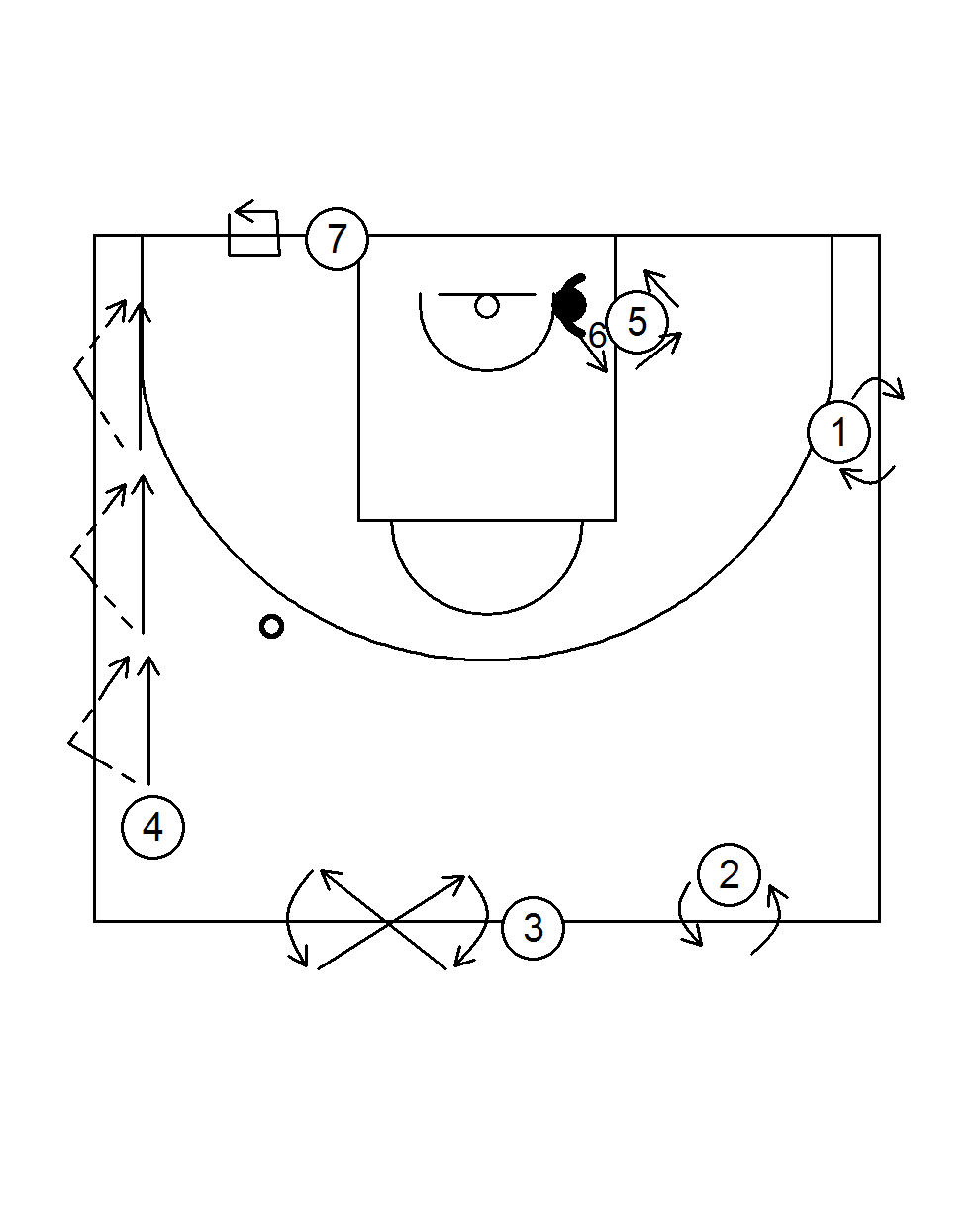
Requirements:
players must know what the correct defensive posture is have
Goal:
- reinforce good habits regarding defensive position
- To increase speed and flexibility of footwork
Organisation:
- do as circuit, 1 minute each time
- player 1 jumps sideways with 2 feet left and right of the line
- player 2 does that forwards and backwards.
- players jump with 2 feet forward wide - narrow - wide. With a jump in the air they do a 180 degree jump and start over again.
- player 4 passes the ball through the wall to himself and goes with slides to the position where he catches it again. Makes it more and more difficult for himself by increasing the distance.
- player 5 defends the mid post and chooses every time another position (behind, swim over - full front - swim over low and back again)
- player 7 makes a square with jumps on 1 foot (feather by landing) always 2x with right, then 2x with left. First left, then right etc.
Teaching points:
- knees bent
- head above the
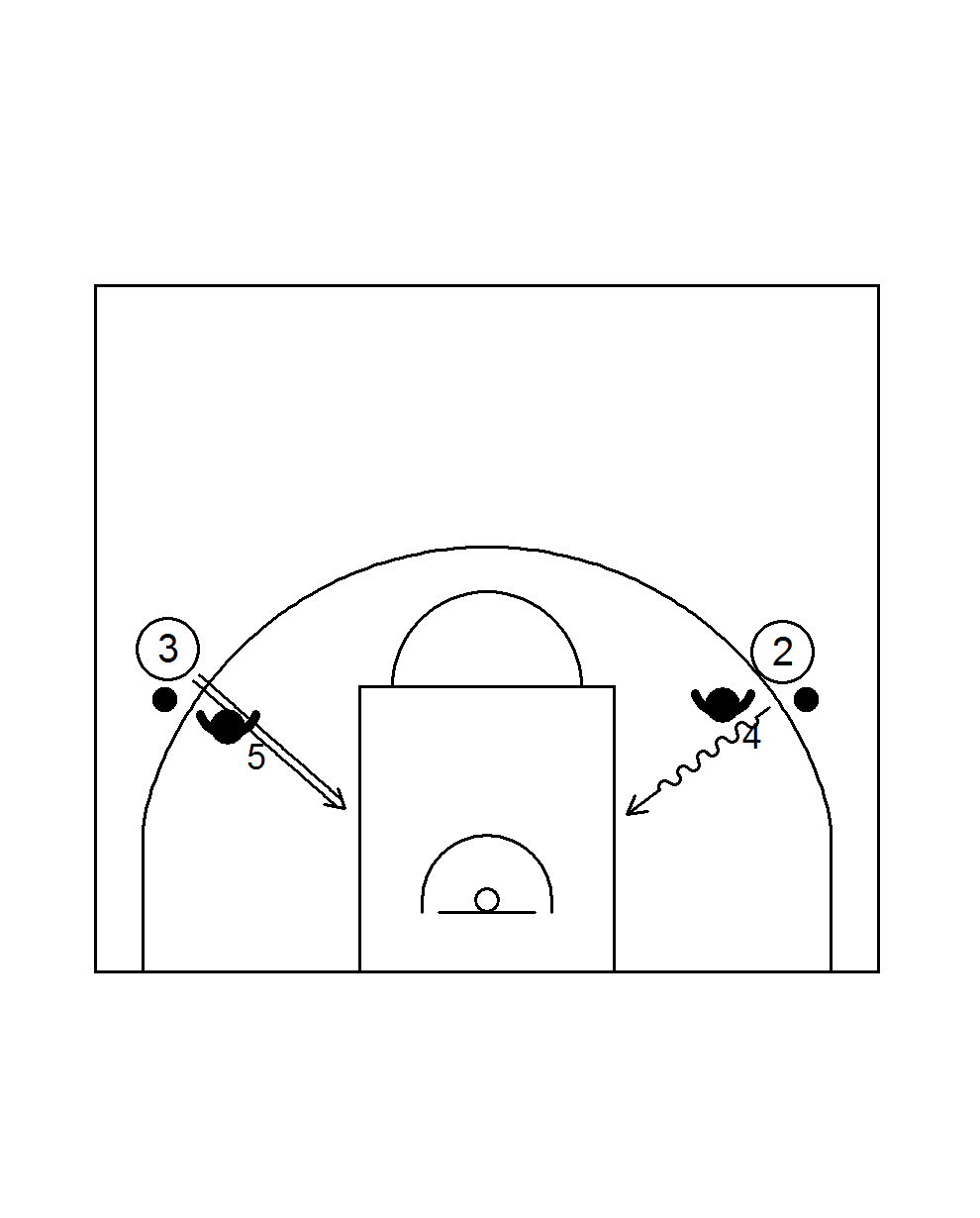
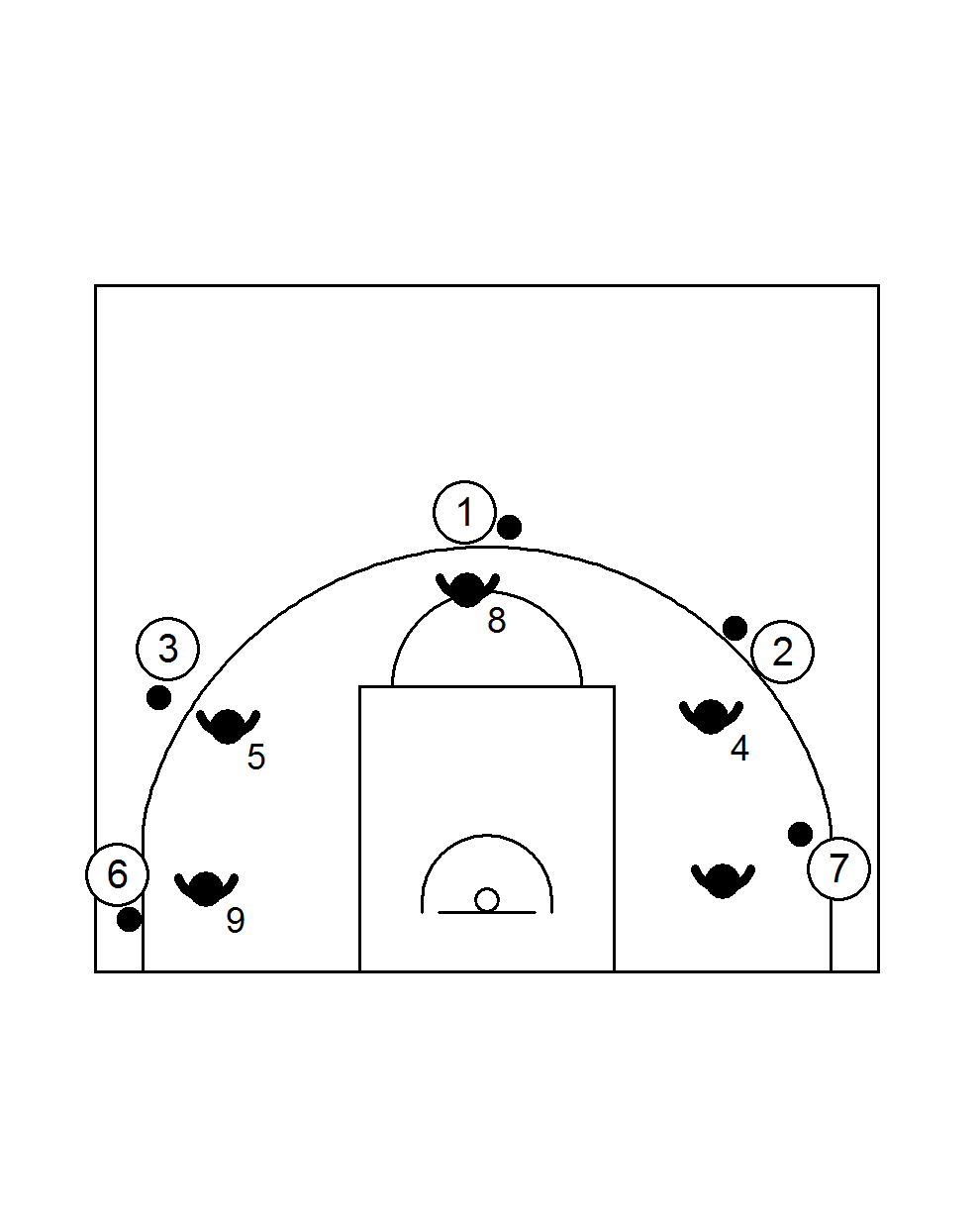
Goal: Defending the forward in triple threat position
Organization:
- attacker makes an agreed number of different feints before shooting or dribbling to the basket
- defender must anticipate with a drop step when the attacker threatens to go over the front foot
- with a two-footed backward hop when the attacker threatens to go over the back foot
- when the attacker brings up the ball, the defender should quickly step towards the attacker, stand against him, feet wider than the attacker,
- Trace the ball with your hands
- When the attacker brings the ball back down, the defender returns to his/her original position with a slide step or a hop backwards (arm's length distance)
Teaching points:
- react quickly on the feet, before the attacker does
- Distance from the attacker: match the threat he poses.
- Shorten the distance to the attacker with mini-slides, so that you can react immediately
Variations:
attacker gives a pass to himself from the bucket edge
Starting exercise:
- defender starts at arm's length
- Square up = feet next to each other, chest perpendicular to the line of the ball-basket when the attacker is standing on the axis of the field.
- Left foot forward when the attacker is standing on the right half of the field and vice versa.
- Attacker fakes the shot
- Defender steps forward, hand on ball
- Attacker brings the ball down
- defender recovers arm-length distance
- attacker makes max 2 dribbles, left or right
- after the stop, the defender steps forward again, hand on the ball
Form of play:
- as above, but with shot + boxing out (= wall and rebound)
- 2 scores in a row (also from the rebound!!) OR 2 stops in a row = loser presses and change
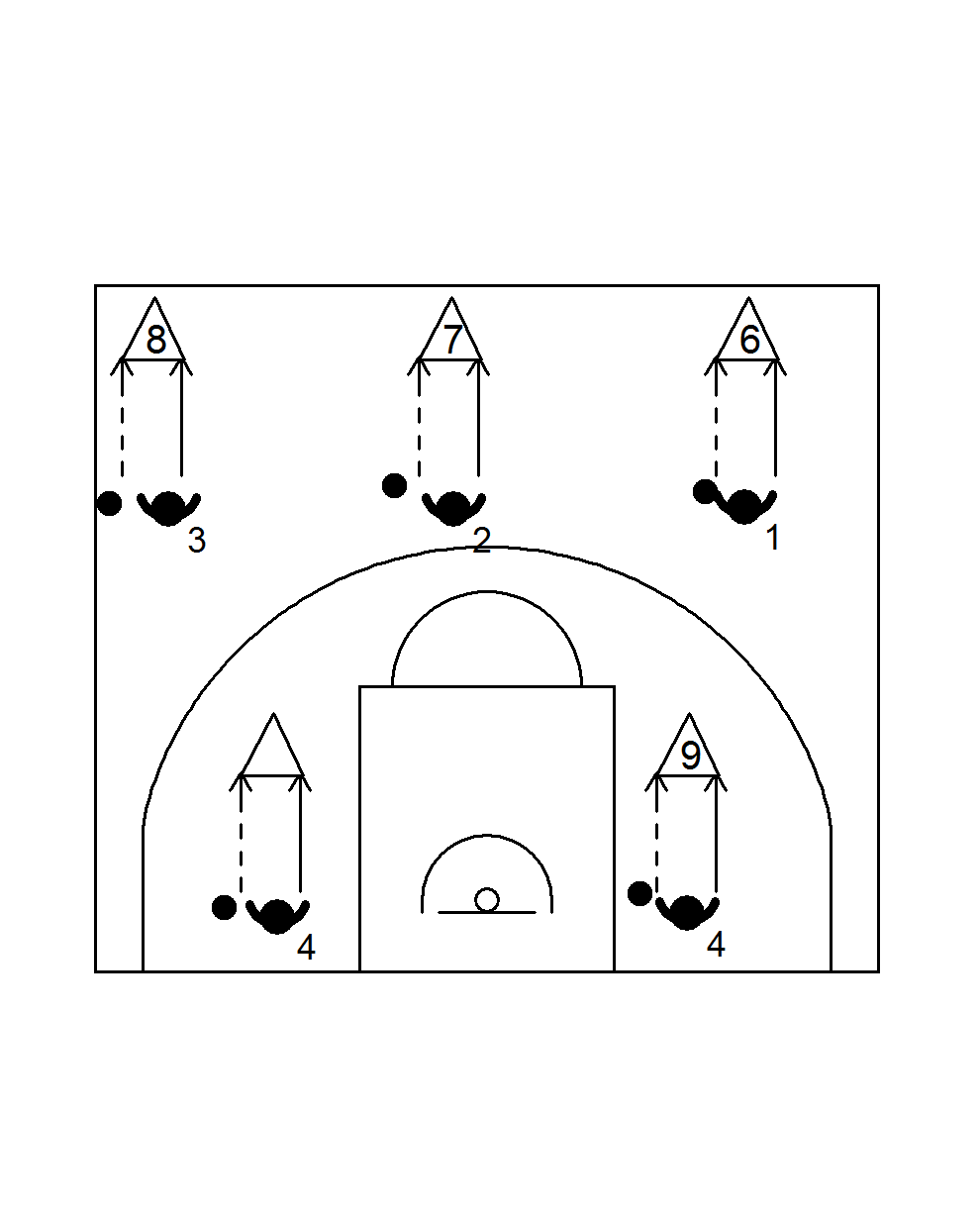
Goal: defend the dribbler after stopping the dribble
Organization:
- man with ball passes to opponent when trainer whistles
- who takes 1 bounce and stops the dribble in 2 Count Rhythm (2TR)
- The trainer counts down 5 seconds and then blows his whistle as end signal
- The aggressive defender steps back to his starting position
- The roles are now reversed
- As soon as the trainer whistles you pass the ball to the other player
- go for it aggressively straight away
- Try to prevent the other player from passing by keeping your hand in front of the ball (trace the ball)
- Try to get your feet to the left and right of the pivot foot of the man with the ball so that he cannot turn
Teaching Points:
- avoid mistakes; do not hit the ball
- Go for the 5 seconds
- Get as close as possible to the attacker (but stay in your own cylinder)
- Move your feet closer to the attacker, but keep your position between the attacker and the basket.
Variations:
- a third man to whom the ball must be passed within 5 seconds. Choose a limited area in which the third man can run free (use lines on the court, or place pawns).
- Pass from under the board to the player on the block. This player must try to pivot past the defender and score. Winner becomes attacker on the block, loser passes from the back line.
Form of play:
- Ten ball on the half court, where the receiver of the ball has to make a dribble start with 1 bounce before he can pass the ball on.
- idem, but defence MUST double team the man with the ball.
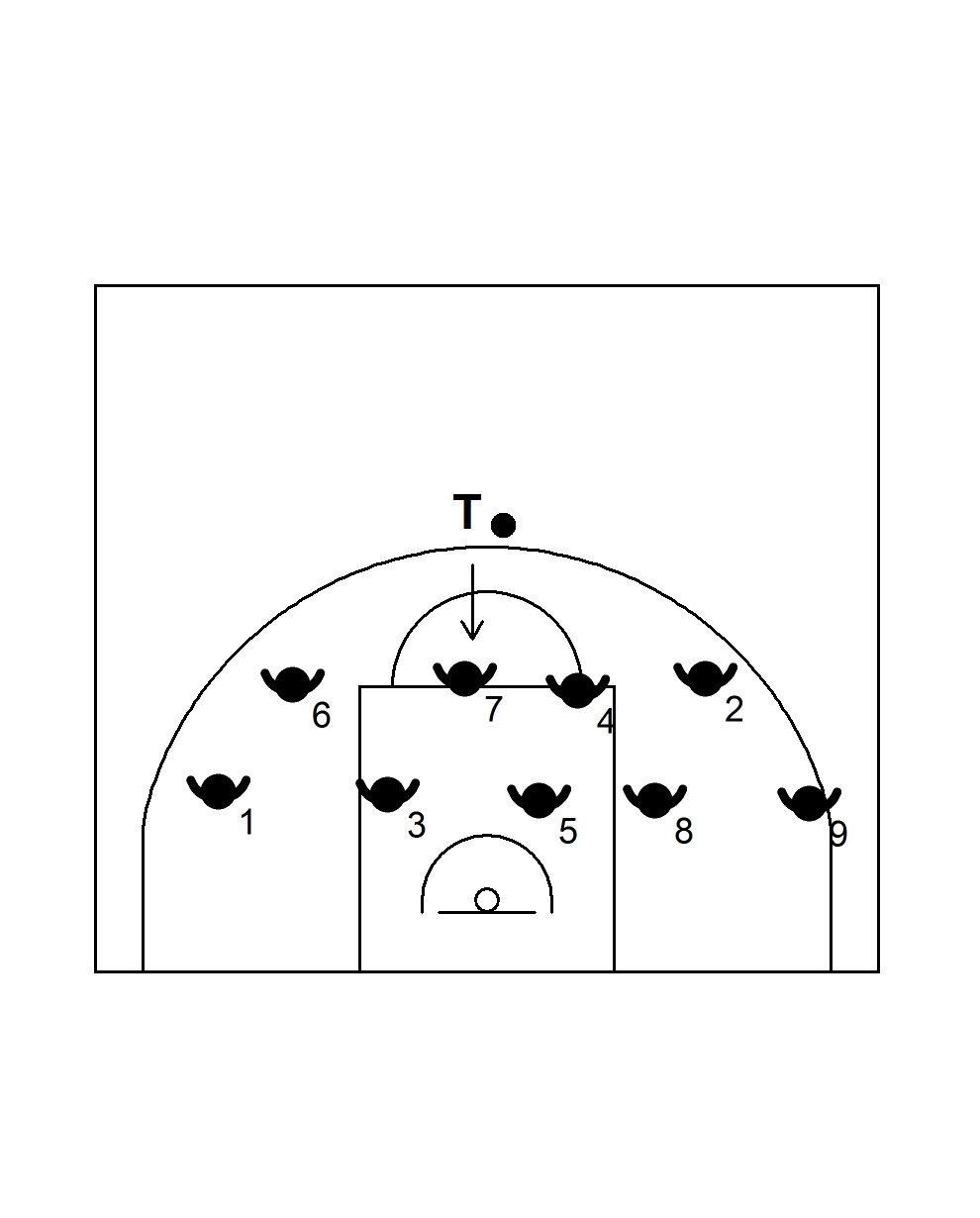
Goal: teach defenders how to catch the attacking foul (= penetrate or charge) (and how to handle physical contact)
Principles:
- when the attacker gets closer, move your feet further apart and lower your butt
- Hard forearm across your navel for protection.
- Always land on both buttocks.
- Land in the direction of penetration.
- roll to your shoulders and bring your legs up for protection
- DO NOT catch with your hands to avoid broken wrists.
- scream while falling
Preparatory exercises:
- players line up in defensive stance
- Trainer walks forward
- players put their feet outward, bring the hard forearm in front of their navel and lower their buttocks
- Trainer shouts "charge".
- players fall and roll on
defend the dribbler
- the trainer makes a zigzag movement
- the players make slide steps and drop steps as if they were defending the dribbler
- as the dribbler approaches, players move their feet outward, bring the hard forearm in front of their belly button and lower their buttocks
- trainer calls 'charge
- players fall on both buttocks in the direction of the penetration and roll through
spin dribble
- the trainer simulates a spin dribble
- players take two quick slide steps around their imaginary attacker, land wide, bring the hard forearm in front of their navel and lower their buttocks
- Trainer calls 'charge'.
- players fall on both buttocks in the direction of penetration and roll through
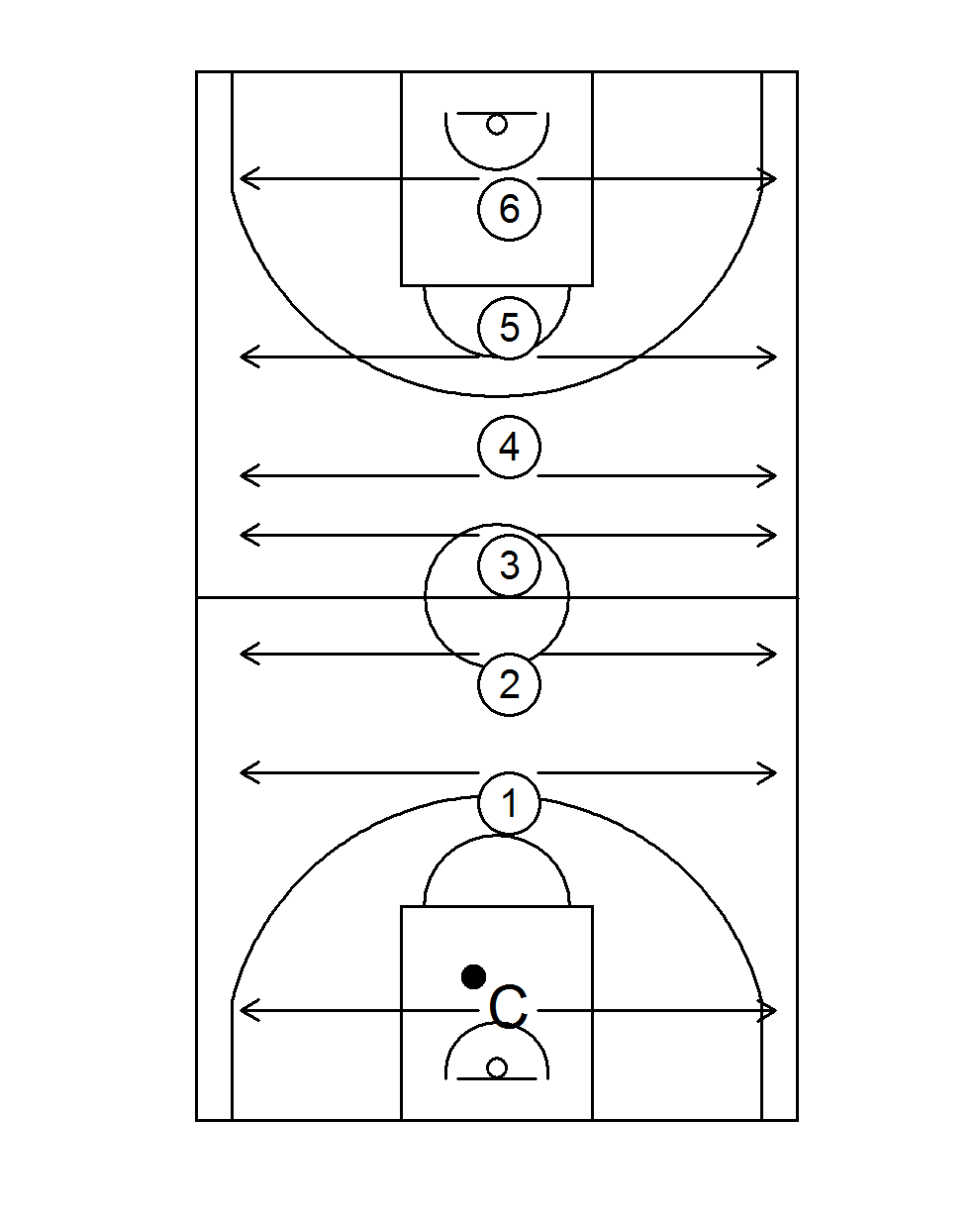
Goal: learn or improve side slides + condition
Organization:
- all players on the helpline, facing the coach
- when coach bounces the ball all players jump into defensive position
- coach moves to the left or to the right, parallel to the backline
- players must stay with their face right in front of the ball
- increase the level of difficulty by changing direction and/or speed at random
Teaching Points:
- feet at least shoulder width
- knees at about 100 degrees (= sitting down deeply)
- shoulders above the heels (= back straight)
- Head upright (overlook the field)
- Hand closest to the ball is low (to be able to tap the ball away on the dribble)
- Other hand is above the shoulder (to intercept a pass)
- push hard on the push-off leg to gain speed
- Feet stay low to the ground (= slide, shuffle)
- feet do not connect after a slide, but remain at shoulder width
Variations:
- let the defender keep his hands on his back if you want to accentuate the feet and stance.
- 1 slide and back to the sideline, 2 slides and back etc. until you reach the sideline; followed by a short fierce sprint back to the sideline
- first a drop step and then slides backwards to the sideline + sprint back
- idem, but first a little tap (quickly transfer weight from one foot to the other)
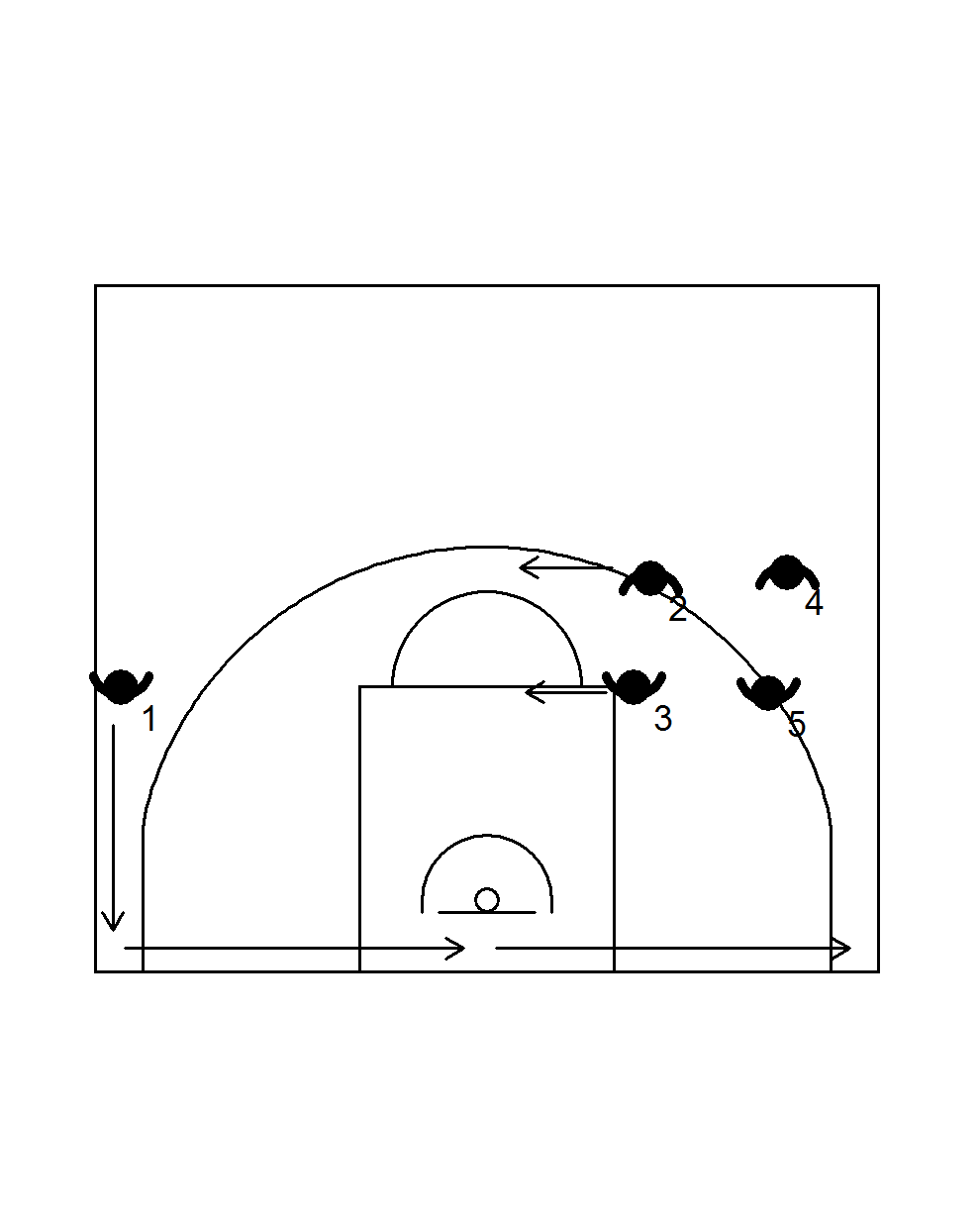
Prerequisites:
players must know what the correct defensive stance is
Goal:
- to reinforce good habits regarding defensive position
- To increase speed and flexibility of footwork
Organisation:
- always 3 minutes
- back over the backline with sprint to the basket and then slides to the sideline facing the centre circle.
- facing each other slowly - wax on wax off
- faster - hold both hands
- only the back hand
- follower holds the leader's shirt
- leader tries to get free by changing speed
- follower tries to keep his head in front of the chest of the leader
Teaching points:
- knees bent
- shoulders above the feet
- front foot pointing in the direction
- hands: wax on - wax off








